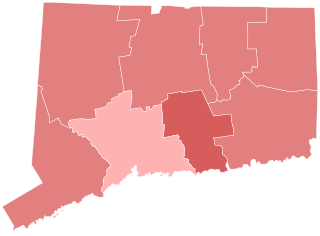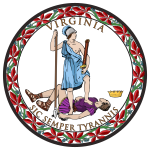
Claude Augustus Swanson was an American lawyer and Democratic politician from Virginia. He served as U.S. Representative (1893–1906), Governor of Virginia (1906–1910), and U.S. Senator from Virginia (1910–1933), before becoming U.S. Secretary of the Navy under President Franklin D. Roosevelt from 1933 until his death. Swanson and fellow U.S. Senator Thomas Staples Martin led a Democratic political machine in Virginia for decades in the late 19th and early 20th century, which later became known as the Byrd Organization for Swanson's successor as U.S. Senator, Harry Flood Byrd.

The 1922 United States Senate elections were elections that occurred in the middle of Republican President Warren G. Harding's term. The 32 seats of Class 1 were contested in regular elections, and special elections were held to fill vacancies. With the Republicans divided between conservative and progressive factions, the Democrats gained six net seats from the Republicans while the Farmer–Labor party gained one. The Republicans retained their Senate majority.

The 1912–13 United States Senate elections were held on various dates in various states. They were the last U.S. Senate elections before the ratification of the Seventeenth Amendment in 1913, establishing direct elections for all Senate seats. Senators had been primarily chosen by state legislatures. Senators were elected over a wide range of time throughout 1912 and 1913, and a seat may have been filled months late or remained vacant due to legislative deadlock. Some states elected their senators directly even before passage of Seventeenth Amendment. Oregon pioneered direct election and experimented with different measures over several years until it succeeded in 1907. Soon after, Nebraska followed suit and laid the foundation for other states to adopt measures reflecting the people's will. By 1912, as many as 29 states elected senators either as nominees of their party's primary or in conjunction with a general election.

The 2008 United States Senate election in Alabama was held on November 4, 2008, to elect one of Alabama's members to the United States Senate. Incumbent Republican U.S. Senator Jeff Sessions won re-election to a third term.

The 1890–91 United States Senate elections were held on various dates in various states. As these U.S. Senate elections were prior to the ratification of the Seventeenth Amendment in 1913, senators were chosen by state legislatures. Senators were elected over a wide range of time throughout 1890 and 1891, and a seat may have been filled months late or remained vacant due to legislative deadlock. In these elections, terms were up for the senators in Class 3.

The 1922 United States Senate elections in Pennsylvania were held on November 7. Incumbent Republican U.S. Senator David A. Reed, who was appointed in August 1922 to fill the vacancy created by the death of William E. Crow, was elected both to complete the remainder of Crow's term, ending in March 1923, and to a full six-year term in his own right, beginning upon the expiration of Crow's term.

The 1922 United States Senate special election in Pennsylvania was held on November 7, 1922. Incumbent Republican Senator George Pepper, who had been appointed to the seat by Governor William Sproul following the death of Boies Penrose, was elected to fill the remaining four years on the term to which Penrose had been elected in 1920. Pepper comfortably defeated five other candidates, including Democratic nominee Fred Kerr of Clearfield County.

The 1928 United States Senate election in Virginia was held on November 6, 1928. Incumbent Senator Claude A. Swanson was re-elected to a fourth term. This is the most recent U.S. Senate election in Virginia history when a candidate ran completely unopposed.

The 1920 United States Senate special election in Virginia was held on Tuesday November 2. Appointed Senator Carter Glass defeated Republican J. R. Pollard and was elected to finish the term of Democrat Thomas S. Martin, who died the previous year. Glass and fellow Senator Claude A. Swanson were the first U.S. senators to be elected by popular vote following the passage of the Seventeenth Amendment.

The 1922 United States Senate election in Connecticut was held on November 7, 1922. Incumbent Republican Senator George P. McLean was re-elected to a third term in office over Democratic attorney Thomas J. Spellacy.

The 1922 United States Senate election in Texas was held on November 7, 1922. Incumbent Democratic U.S. Senator Charles Culberson ran for re-election to a fifth term, but lost the Democratic primary. A runoff was held between former Governor Pa Ferguson and Railroads Commissioner Earle Bradford Mayfield.

The 1922 United States Senate election in Tennessee was held on November 7, 1922. Incumbent Democratic Senator Kenneth D. McKellar was re-elected to a second term in office, defeating Republican former interim Senator Newell Sanders.

The 1922 United States Senate election in Missouri was held on November 7, 1922. Incumbent Democratic U.S. Senator James A. Reed was re-elected to a third term over Republican R. R. Brewster.

The 1922 United States Senate election in Minnesota took place on November 7, 1922. Farmer–Labor challenger Henrik Shipstead defeated incumbent Republican U.S. Senator Frank B. Kellogg and Democratic challenger Anna Dickie Olesen.

The 1922 United States Senate election in Michigan was held on November 7, 1922. Incumbent Republican Senator Charles E. Townsend ran for re-election to a third term in office, but was defeated by Democratic former Governor Woodbridge N. Ferris. Ferris was the first Democrat popularly elected to represent Michigan in the Senate, as Democrats last won a Senate seat in 1859, and last held this seat in 1857.

The 1922 United States Senate election in Florida was held on November 7, 1922.

The 1922 United States Senate election in California was held on November 7, 1922. Incumbent Republican Senator Hiram Johnson was re-elected to his second term in office.

The 1922 United States Senate special election in Iowa took place on November 7, 1922. Republican Smith W. Brookhart was elected to complete the unexpired term of William S. Kenyon, defeating Democrat Clyde Herring.

The 1922 United States Senate election in Delaware took place on November 7, 1922. This election pitted Delaware's two most powerful families, the Republican du Ponts and the Democratic Bayards, against each other.




















